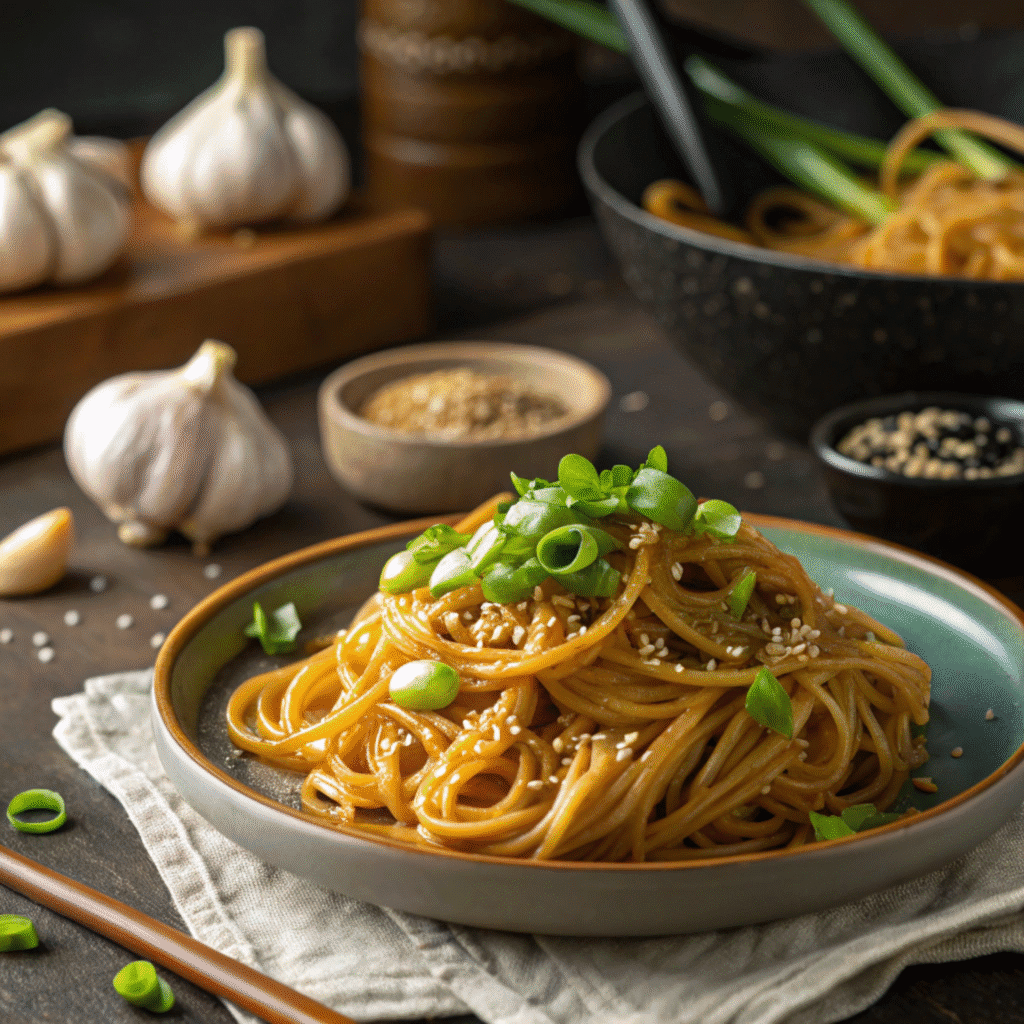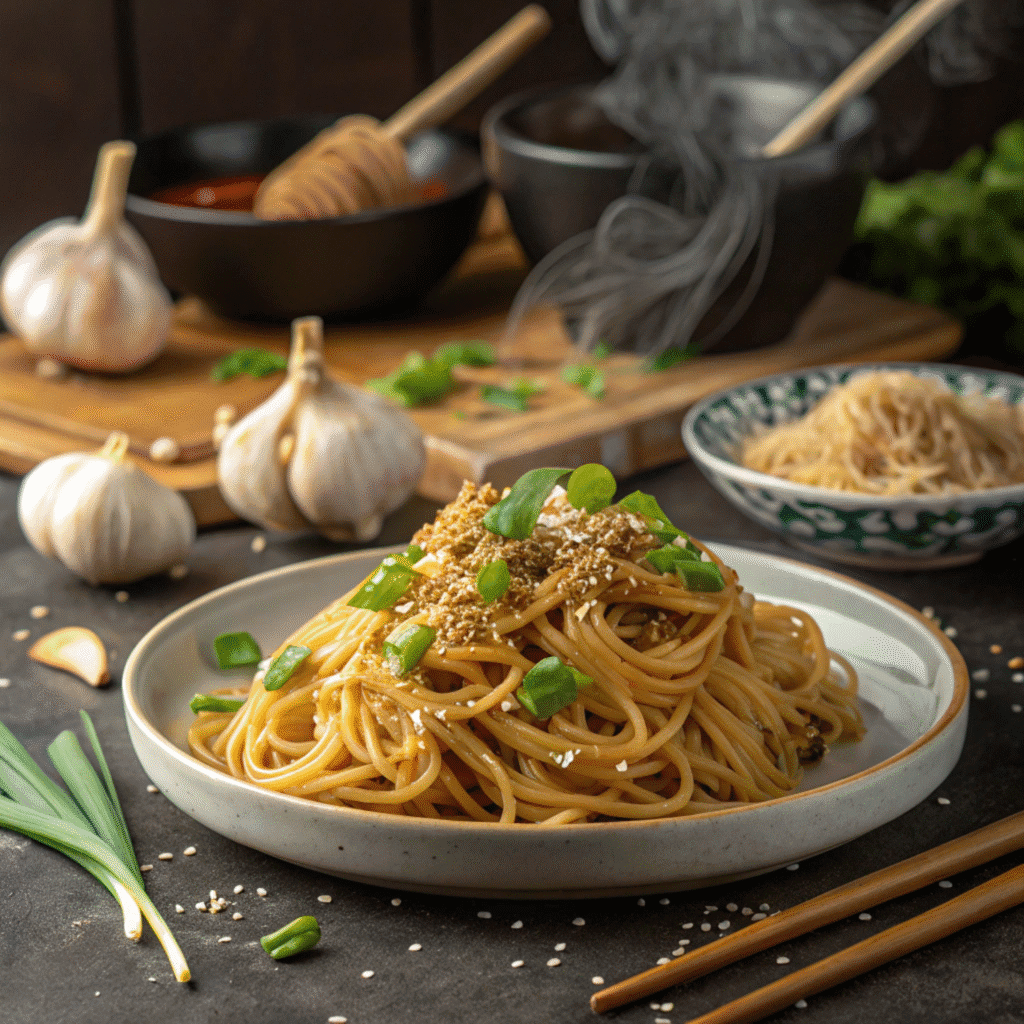
Garlic noodles captivate food lovers with their bold, savory flavors and simple preparation. This dish, blending aromatic garlic with tender noodles, has become a global favorite. In this article, we explore the origins of garlic noodles, their nutritional benefits, how to make them at home, and why they deserve a spot in your culinary repertoire.
What Are Garlic Noodles?
Garlic noodles combine stir-fried noodles with a rich, garlicky sauce. The dish often features ingredients like soy sauce, oyster sauce, butter, and green onions, creating a perfect balance of umami, savory, and slightly sweet flavors. While simple, the dish delivers a powerful taste that appeals to diverse palates.
The Origins of Garlic Noodles
Garlic noodles trace their roots to Vietnamese-American cuisine, specifically from the San Francisco Bay Area. Chef Helene An, of the renowned Thanh Long restaurant, popularized the dish in the 1970s. Her creation blended Vietnamese flavors with Western influences, using garlic, butter, and oyster sauce to coat egg noodles. This fusion dish quickly gained popularity, spreading across the U.S. and beyond.
The dish draws inspiration from Asian stir-fry noodle traditions, particularly Chinese and Vietnamese cuisines. Garlic, a staple in Asian cooking, takes center stage, while the use of butter reflects Western culinary techniques. This unique combination makes garlic noodles a standout in fusion cuisine.
Why Garlic Noodles Are So Popular
Garlic noodles owe their popularity to their simplicity and bold flavors. The dish requires minimal ingredients, making it accessible for home cooks. Its versatility allows it to pair well with proteins like shrimp, chicken, or tofu, or to shine as a standalone dish. Restaurants worldwide now feature garlic noodles on their menus, often adding their own twists, such as chili flakes for heat or sesame seeds for texture.
Nutritional Benefits of Garlic Noodles
Garlic noodles offer more than just great taste—they provide nutritional value too. Here’s a breakdown of the key ingredients and their benefits:
- Garlic: Packed with allicin, garlic boosts immunity, supports heart health, and has anti-inflammatory properties. It also adds antioxidants to the dish.
- Noodles: Depending on the type (egg, wheat, or rice noodles), noodles provide carbohydrates for energy. Whole-grain options add fiber, aiding digestion.
- Butter: While used sparingly, butter contributes healthy fats and enhances flavor absorption.
- Soy Sauce and Oyster Sauce: These add sodium and umami but should be used in moderation to manage salt intake.
- Green Onions: Rich in vitamins A and C, green onions support immune function and add a fresh crunch.
A typical serving of garlic noodles (about 1 cup or 150 grams) contains approximately:
- Calories: 250–300 kcal
- Protein: 6–8 grams
- Fat: 10–12 grams
- Carbohydrates: 35–40 grams
- Fiber: 1–2 grams (higher with whole-grain noodles)
To make garlic noodles healthier, opt for whole-grain or vegetable-based noodles, reduce butter, and use low-sodium soy sauce.
How to Make Garlic Noodles at Home
Cooking garlic noodles at home is straightforward and requires minimal equipment. Follow this step-by-step recipe to create a restaurant-quality dish in under 30 minutes.
Ingredients (Serves 4)
- 8 oz (225g) egg noodles or spaghetti
- 4 tablespoons unsalted butter
- 6–8 garlic cloves, minced
- 2 tablespoons oyster sauce
- 2 tablespoons soy sauce (low-sodium preferred)
- 1 tablespoon fish sauce (optional, for extra umami)
- 1 teaspoon sugar
- 1/4 cup grated Parmesan cheese (optional, for a cheesy twist)
- 2 green onions, thinly sliced
- 1 tablespoon sesame oil (optional, for added flavor)
- Red chili flakes (optional, for spice)
Equipment
- Large pot for boiling noodles
- Large skillet or wok
- Tongs or spatula
- Colander
Step-by-Step Instructions
- Cook the Noodles: Bring a large pot of water to a boil. Add a pinch of salt and cook the noodles according to package instructions until al dente (about 6–8 minutes for egg noodles). Drain and set aside, reserving 1/4 cup of the cooking water.
- Prepare the Garlic Sauce: In a large skillet or wok, melt the butter over medium heat. Add the minced garlic and sauté for 1–2 minutes until fragrant but not browned. Stir constantly to prevent burning.
- Add Sauces and Seasonings: Stir in the oyster sauce, soy sauce, fish sauce (if using), and sugar. Cook for 1 minute, allowing the flavors to meld. If the sauce thickens too much, add a tablespoon of reserved noodle water to loosen it.
- Toss in the Noodles: Add the cooked noodles to the skillet. Use tongs to toss the noodles in the sauce, ensuring they’re evenly coated. Cook for 2–3 minutes until the noodles absorb the flavors.
- Add Finishing Touches: Sprinkle in the Parmesan cheese (if using) and green onions. Drizzle with sesame oil for extra richness. Toss everything together and cook for another minute.
- Serve Immediately: Divide the garlic noodles among plates. Garnish with extra green onions or chili flakes for a spicy kick. Pair with your favorite protein or enjoy as is.
Tips for Perfect Garlic Noodles
- Don’t Burn the Garlic: Keep the heat at medium and stir constantly to avoid a bitter taste.
- Customize the Protein: Add shrimp, chicken, or tofu during the sauce-making step for a heartier dish.
- Adjust the Sauce: Taste the sauce before adding noodles and adjust with more soy sauce or sugar if needed.
- Use Fresh Ingredients: Fresh garlic and green onions enhance the dish’s flavor significantly.

Variations of Garlic Noodles
Garlic noodles are highly adaptable. Here are some popular variations to try:
- Spicy Garlic Noodles: Add chili oil or red chili flakes for a fiery kick.
- Vegetarian Garlic Noodles: Swap oyster sauce for mushroom-based sauce and add vegetables like bell peppers or broccoli.
- Seafood Garlic Noodles: Toss in shrimp, crab, or scallops for a luxurious twist.
- Cheesy Garlic Noodles: Stir in Parmesan or cheddar for a creamy, indulgent version.
- Gluten-Free Garlic Noodles: Use rice noodles and tamari instead of soy sauce.
Pairing Suggestions for Garlic Noodles
Garlic noodles pair well with a variety of dishes and beverages. Consider these options:
- Proteins: Grilled shrimp, teriyaki chicken, or crispy tofu complement the dish’s bold flavors.
- Vegetables: Serve with a side of stir-fried bok choy, snap peas, or a fresh cucumber salad.
- Drinks: Pair with a crisp white wine, iced green tea, or a light lager to balance the richness.
- Desserts: Finish the meal with mango sticky rice or sesame balls for a sweet contrast.
Cultural Significance of Garlic Noodles
Garlic noodles represent the beauty of culinary fusion. They embody the creativity of immigrant communities, particularly Vietnamese-Americans, who blended their heritage with local ingredients. The dish has become a symbol of cultural integration, appearing in restaurants, food trucks, and home kitchens worldwide. Its adaptability allows chefs and home cooks to add their own flair, making it a beloved dish across cultures.
Storing and Reheating Garlic Noodles
To store leftover garlic noodles, place them in an airtight container and refrigerate for up to 3 days. To reheat, warm them in a skillet over medium heat with a splash of water or oil to prevent sticking. Avoid microwaving, as it can make the noodles soggy and unevenly heated.
Garlic Noodles in Restaurants
Many restaurants, especially in the U.S., feature garlic noodles on their menus. Thanh Long in San Francisco remains a must-visit for the original version. Other notable spots include:
- Crustacean (Beverly Hills, CA): Known for their signature garlic noodles with crab.
- PPQ Dungeness Island (San Francisco, CA): Offers a classic version with fresh seafood.
- Asian Box (Various Locations): Features a street-food-inspired take with customizable toppings.
When dining out, ask about the restaurant’s unique spin on garlic noodles—some add truffle oil or specialty sauces for an elevated experience.
Common Mistakes to Avoid
To ensure your garlic noodles turn out perfectly, steer clear of these pitfalls:
- Overcooking the Noodles: Cook to al dente to prevent a mushy texture.
- Burning the Garlic: Burnt garlic tastes bitter and can ruin the dish.
- Overloading the Sauce: Too much sauce can make the noodles soggy. Start with small amounts and adjust as needed.
- Skipping Fresh Ingredients: Pre-minced garlic or dried green onions lack the vibrancy of fresh ones.
Garlic Noodles for Special Diets
Garlic noodles can be adapted for various dietary needs:
- Vegan: Use vegan butter and replace oyster sauce with mushroom sauce.
- Gluten-Free: Opt for rice noodles and tamari or gluten-free soy sauce.
- Low-Carb: Substitute noodles with zucchini noodles or shirataki noodles.
- Low-Sodium: Use low-sodium soy sauce and reduce the amount of oyster sauce.
Fun Facts About Garlic Noodles
- Global Appeal: Garlic noodles have inspired dishes in countries like Japan, Australia, and the UK.
- Social Media Star: The dish trends on platforms like Instagram and TikTok, with foodies sharing their recipes.
- Versatile Base: Garlic noodles serve as a base for creative dishes, from noodle soups to casseroles.
- Quick Prep: The dish can be made in under 30 minutes, perfect for busy weeknights.
Why You Should Try Garlic Noodles
Garlic noodles deliver bold flavors, easy preparation, and endless customization options. Whether you’re a seasoned cook or a beginner, this dish offers a satisfying meal that’s both comforting and exciting. Its cultural significance and nutritional benefits make it more than just a meal—it’s a culinary experience.
Garlic noodles combine simplicity, flavor, and versatility in one delicious package. From their Vietnamese-American origins to their global popularity, they’ve earned their place as a beloved dish. With this guide, you can whip up a batch at home, experiment with variations, and enjoy the health benefits of garlic. So grab your ingredients, fire up the stove, and dive into the world of garlic noodles today!

